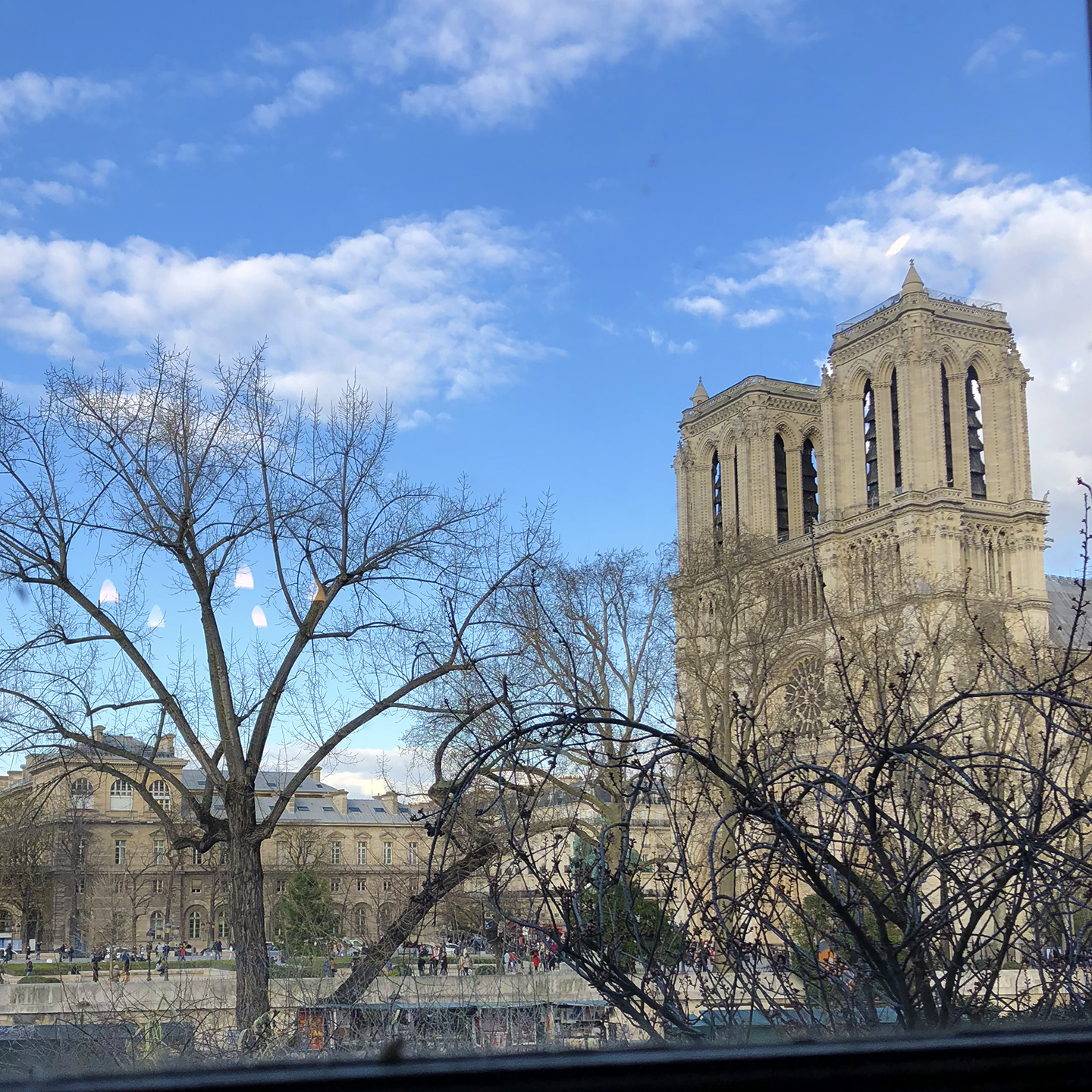This is not the post I was planning to publish this week. We all saw the horrible images of the devastating fire that devoured Notre-Dame de Paris yesterday. Pumping water from the nearby Seine, 400 heroic firefighters managed to save the two towers, the façade, and the overall structure of the cathedral; they also secured some of the most precious relics and artworks. The 800-year-old wood frame that supported the roof, along with the spire, burned down. Damage to the grand pipe organ and the stunning stained-glass roses will need to be evaluated.
A rare photo of Notre-Dame on a snowy day
Worldwide emotion was palpable in the surrounding streets, on TV, and on the web. Sorrow was shared by French and non-French, the faithful and the occasional tourist. It showed the cathedral had truly earned its given name: OUR lady. Since the 12th century, it has been the soul of Paris. It bore witness to fundamental moments of French history: Henri IV’s marriage, Napoléon’s coronation, the Liberation from Nazi Germany. It’s the most visited monument in Europe. It’s listed as a World Heritage Site. It belongs to the world, to all of us.
Magical at night
Transcending its religious significance, the cathedral became a tribute to civilization and human know-how. Thousands of artists and artisans contributed their creativity, skills, sweat, and tears over nine centuries to build a structure so unique that it inspired writers, painters, photographers, and musicians. Millions of American children were introduced to Notre-Dame via Disney’s Ratatouille. Millions of French children discovered it through Victor Hugo’s novel. I was one of them.
From the terrace of the Insitut du Monde Arabe
Notre-Dame was my neighbor while I was a student in the Latin Quarter in the mid-70s. On a whim, after an afternoon math class that was taking place a block away, I decided to check out the view from the top. I got my ticket at the tiny guérite on the North side of the North tower and proceeded to climb 387 narrow spiraling steps. My efforts were rewarded with the most magnificent view of Paris. Yes, I think it’s better than the Eiffel Tower because of its central location and proximity to other significant sites. I made the climb on three other occasions, usually with some American guests in tow.
Stained glass in one of the lateral chapels
The keystone
I attended mass at Notre-Dame only once, in September 2011. Mom had joined me while I was in Paris for a trade show. Her mobility was a bit impaired. I picked activities that would not require her to walk too much. We chose a Gregorian mass on Sunday and sat in the middle of the nave while visitors filed through the ambulatory. The organ and the chants were glorious. Entrance to the cathedral was always free and I was amazed to see how tourists and faithful could cohabit with limited disturbance.
Gargoyles
Just about every trip to Paris led me to the site; at the very least, I strolled on the parvis or in square Jean XXIII that borders the cathedral to the South and East. I would see it from Montmartre and Belleville, from pont des Arts and pont d’Austerlitz, from Beaubourg and Institut du Monde Arabe. It was always nearby. It was eternal, or so I thought. Like everybody else, I took it for granted.
One of my early shots (almost 20 years ago) from quai de Montebello
Emmanuel Macron vowed that we would rebuild the cathedral, a gigantic endeavor. The Middle Ages were known as the era of cathedral builders; perhaps the 21st century will usher a similar period since it appears that everybody wants to be part of the reconstruction effort.
From pont de la Tournelle
I’m not sure I’ll still be around to walk into the “new” Notre-Dame but that didn’t stop the thousands of craftsmen who started building the original structure in 1160: those bâtisseurs were fully aware they would never see the result of their hard work. But they also knew they were serving a higher purpose: expressing their faith in God. Today, we can be new bâtisseurs with another purpose: expressing our faith in man and our appreciation of heritage. So that future generations of children can climb 387 steps, gaze at gargoyles, and embrace the splendid city below.
Official website for the fundraising campaign
Through an upstairs window at Shakespeare and Co.
Vocabulary
La guérite: booth
Le parvis: esplanade
Le bâtisseur: builder
My very last photo of the cathedral. Taken on March 19, 2019. The spire and the South rose reflected in the window of Charbonnel, a fine art supply shop on quai de Montebello.











